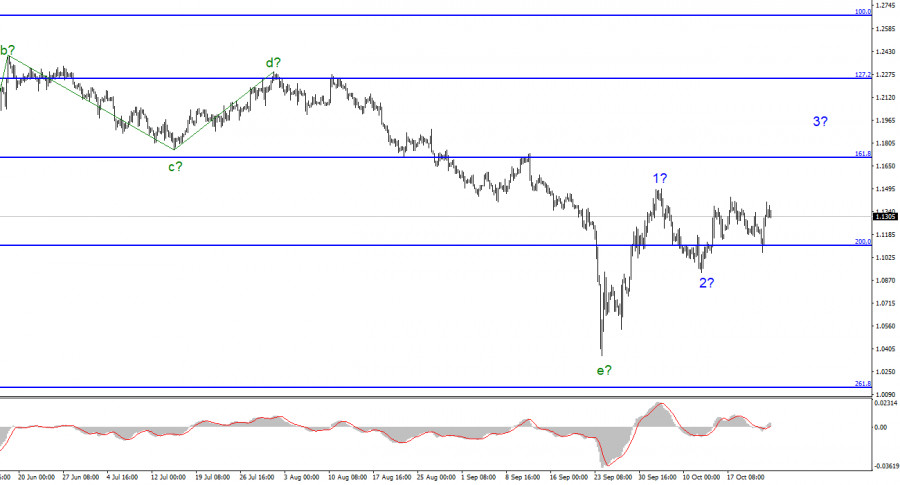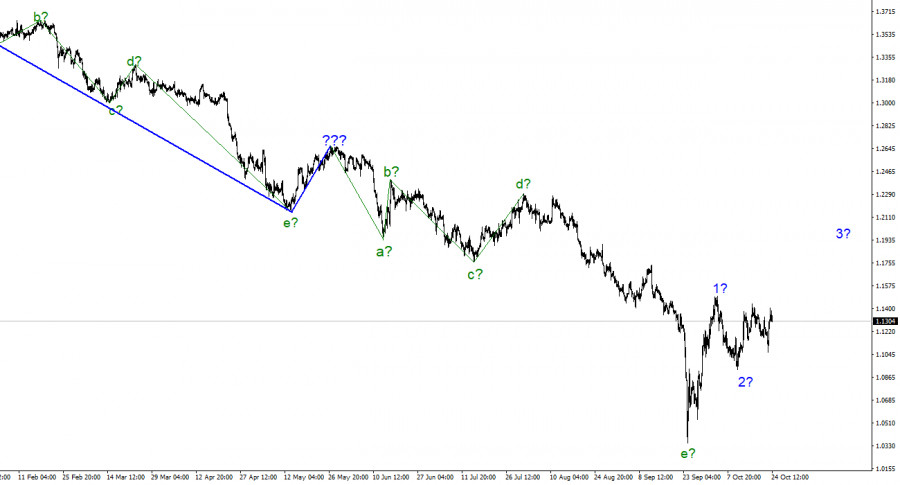
For the pound/dollar instrument, the wave marking looks quite complicated at the moment but still does not require any clarification. We have a supposedly completed downward trend segment, which consists of five waves a-b-c-d-e. If this is indeed the case, then the construction of a new upward trend section has begun. Its first and second waves are presumably completed. Unfortunately, there is no confidence in this particular scenario since the instrument must go beyond the peak of the last wave in order to show us its readiness to build an upward section of the trend and not complicate the downward one once again. And the peak of the nearest wave d is located about 23 figures. Thus, even after the pound has increased by 1000 points, you need to go up another 1000 points to get to this peak. Nevertheless, an unsuccessful attempt to break through the 200.0% Fibonacci level indicates that the market is ready to buy the pound. Thanks to this, I think that the euro currency can also go up. So far, the wave marking for the British looks more or less convincing, but it can easily transform into a downward one. Especially if the news background deteriorates again.
Disappointing but predictable statistics from Britain.
The exchange rate of the pound/dollar instrument decreased by 110 basis points on October 24. But if we count from Friday's close, then the British did not lose almost anything since Monday opened with an upward gap. Nevertheless, in the first half of Monday, demand for the pound was falling. For the same reasons as the demand for the euro. British business activity indices were weaker than market expectations, below the 50.0 mark. Thus, the British cannot get such a new background in any way to continue building an upward wave and grow above the peak of wave 1. This could help me determine which section of the trend is currently being built on the pound, and, most likely, the same section of the trend could be identified on the euro. But there are no successful attempts to break through important peaks, so both instruments retain chances of both an increase and a decrease.
The British pound has no fewer problems now than the European currency. By and large, both currencies continue to depend on the dollar, on demand for the dollar, and on America. The market does not understand why it should buy the pound or the euro now if the news background for these currencies remains negative. Let me remind you that inflation in the US has been slowing down for three months in a row, while inflation in Britain and the EU continues to grow. In the US, they are already thinking about reducing the rate of increase in the key rate because there is no need for steps of 0.75%. In the European Union and Britain, they are still forced to raise the rate at the maximum pace, but the problem for them is different: will their economies withstand rate increases up to 4-5%? Many analysts are of the opinion that they will not stand it, and both regulators may refuse to raise the rate further simply because the economy will deepen into recession, from which it is also necessary to get out later. The dollar still looks more stable and confident than the euro or the pound.

General conclusions.
The wave pattern of the pound/dollar instrument assumes the construction of a new upward trend segment. Thus, now I advise buying the instrument on the MACD reversals "up" with targets located near the estimated mark of 1,1705, which equates to 161.8% Fibonacci. Be careful with sales and purchases since the downward section of the trend may become more complicated once again.
At the higher wave scale, the picture is very similar to the Euro/Dollar instrument. The same ascending wave that does not fit the current wave pattern, the same five waves down after it. The downward section of the trend can turn out to be almost any length, but it may already be completed.
Trading analysis offered by Flex EA.
Source






